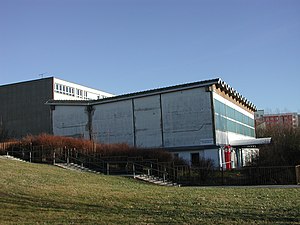Frankenberg Vehicle Museum
 Vehicle museum building |
|
| Data | |
|---|---|
| place | Mühlbacher Strasse 7, 09669 Frankenberg / Sa. |
| Art | |
| opening | 1996 |
| operator |
Non-profit association for vehicle museum Frankenberg / Sa. eV
|
| Website | |
| ISIL | DE-MUS-960412 |
The vehicle museum Frankenberg is a regional museum opened in 1996 in the Saxon town of Frankenberg , in which more than 100 exhibits show the history of commercial vehicle development, especially of the types Framo and Barkas, almost completely.
Creation of the museum
In 1993, employees of Barkas GmbH founded the Förderverein Fahrzeugmuseum Frankenberg eV , which soon received support from the city administration, from what was then APEX GmbH , from the regional employment offices and from numerous individuals for building up a collection . - The city made the premises available, former employees of the Barkas works and many private enthusiasts and collectors brought together the exhibits.
The materials had to be viewed and sorted, contemporary witnesses interviewed and, above all, many vehicles restored before they were shown in the small exhibition. Many friends of the museum worked on a voluntary basis, so that the museum could be officially opened after just three years.
collection
The origins and development of commercial vehicle production at the Frankenberg site and their successor models from Hainichen and Karl-Marx-Stadt are shown in short presentations and with original vehicles .

introduction
The Danish engineer Jørgen Skafte Rasmussen , who was already successful in other business areas , founded Metallwerke Frankenberg GmbH in the city of Frankenberg on January 23, 1923 together with engineers Paul Figura and Richard Blau. The main products were accessories for DKW motorcycles . This later resulted in the first motor-driven three-wheeled transport vehicles, the single front wheel of which was driven directly with the simple and uncovered motor via a chain, as the picture on the right clearly shows. (More on the history of the vehicle types under Framo and VEB Barkas-Werke .)
Information boards
There are 60 themed panels on motorcycle production, on the development of the “innards” such as the engines, (at that time) new types of brake systems; old advertising posters and original traffic signs.
Technology insights
Many cutaway models and opened vehicle parts explain to visitors how the necessary car technology works. Promotional items and toy models for the transporters shown loosen up the technical presentation.
vehicles
The heart of the museum are 19 (as of September 2015) original vehicles, most of which have since been reconstructed and brought to a "high gloss". Original Framo models such as the D 500 P , V501 , Piccolo and others are shown in five small rooms . In other rooms, parts of the Barkas can be seen, from its beginnings to the various superstructures up to the “masterpiece”, the prototype of a vehicle that was never produced, the B1100 .
The small van, called Barkas B1100 , was newly developed until 1972 and was manufactured in three prototypes. Series production could never begin because the development had to be discontinued on the instructions of the responsible ministry (Ministry of Machinery, Agricultural Machinery and Vehicle Construction of the GDR ) due to a lack of material. These new developments and numerous design improvements (such as independent wheel suspension and longitudinal torsion beam suspension) were never used in this way. Although the prototypes were supposed to be scrapped, all three were saved from this fate by the responsible development engineer Walter Richter: he found hiding places among farmers for the dismantled car parts. And after the political change, the parts were put together so that one of the three prototypes can be presented to visitors in this museum. The last B 1000 with a two-stroke engine and the B 1000-1 with a VW license engine manufactured on April 10, 1991 are also on display.
Other exhibits
Chassis of a Barkas B 1000
See also
Sources and web links
- Flyer of the vehicle museum Frankenberg, status 2008
- Detailed presentation of the company's history and type tables on a private homepage
- Museum website
- Book Framo & Barkas, The history of the 2-stroke transporter from Saxony, Günther Wappler ISBN 3-931-770-63-X WMS advertising Thum
Individual evidence
- ↑ Presentation of the museum for the exhibition ; accessed on September 16, 2015.







